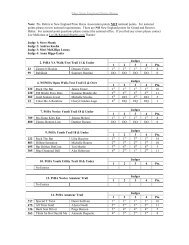2011 Official Rule Book - New England Pinto Horse Association
2011 Official Rule Book - New England Pinto Horse Association
2011 Official Rule Book - New England Pinto Horse Association
You also want an ePaper? Increase the reach of your titles
YUMPU automatically turns print PDFs into web optimized ePapers that Google loves.
Going around the corner of the arena before turning<br />
the cow when going down the fence (when the cow’s head<br />
breaks the plane of the 2-point penalty marker).<br />
4. One (1) Point penalties<br />
a. Loss of working advantage<br />
b. For each length horse runs past cow. A length is one<br />
horse length of daylight between the cow’s head and<br />
the top of the horse’s tail.<br />
c. Using the corner or the end of the arena to turn the<br />
cow when going down the fence. In an oval arena,<br />
when the cow’s head breaks the plane of the end<br />
marker.<br />
d. Changing sides of arena to turn cow (1 point/time)<br />
e. Slipping a rein<br />
f. Turning cow before passing middle marker on first turn<br />
5. Zero (0) score<br />
a. Turning tail to the cow<br />
b. Fingers between the reins except when riding a junior<br />
horse ridden two-handed in a snaffle bit or bosal<br />
c. Deliberate spurring or use of the romal forward of the<br />
cinch<br />
d. Leaving the work area before the pattern or work is<br />
complete<br />
e. During the cow work, use of two hands on the reins,<br />
except with junior horses ridden two handed in a<br />
snaffle bit or bosal.<br />
f. Fall of horse or rider<br />
g. Balking<br />
h. Schooling the horse between the rein and cow work<br />
when the cow work immediately follows rein work.<br />
6. Elimination<br />
a. Any horse that is out of control while working the cow,<br />
thus endangering the rider (i.e. crossing the path of<br />
the cow) shall be called off the cow.<br />
b. Any horse that runs over the cow, causing the fall of<br />
horse and/or rider shall terminate the work at that time.<br />
G. The judge may blow his whistle at any time to terminate the<br />
work. A score of zero (0) will be charged if the work is not<br />
complete at that point..<br />
H. The following characteristics of the horse are considered<br />
faults:<br />
1. Exaggerated opening of the mouth<br />
2. Hard or heavy mouth<br />
3. Nervous throwing of head<br />
4. Lugging on bridle<br />
5. Halting or hesitation while being shown, particularly when<br />
being run out, indicating anticipation of being set up.<br />
6. Losing a cow or being unable to finish a pattern because<br />
of a bad cow – the contestant should be penalized at the<br />
judge’s discretion.<br />
7. Touching the horse or saddle with the free hand except<br />
during the cow-work portion of the class where the rider<br />
may hold onto the horn.<br />
I. The characteristics of a good working cow horse are:<br />
1. Good manners.<br />
2. Shifty, smooth and having its feet under it at all times;<br />
when stopping, hind feet should be well under it.<br />
3. A soft mouth and should respond to a light rein, especially<br />
when turning.<br />
4. Head should be maintained in its natural position.<br />
5. Work at reasonable speed and still be under control of the<br />
rider.<br />
<strong>2011</strong> PtHA <strong>Rule</strong> <strong>Book</strong> 131<br />
ClassEs



